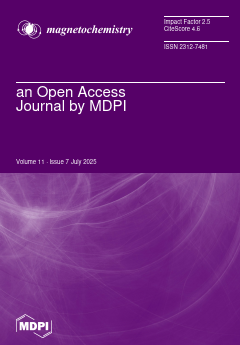In this study, we investigate the presence of the Griffiths-like anomaly in the geometrically frustrated antiferromagnet
and globally its absence in
, despite only small differences in the ionic radii,
f
[...] Read more.
In this study, we investigate the presence of the Griffiths-like anomaly in the geometrically frustrated antiferromagnet
and globally its absence in
, despite only small differences in the ionic radii,
f-electron occupancy, and the corresponding crystal structures of the
and
-members. Previous studies have identified the Griffiths phase in the Dy-analog,
, suggesting certain inherent features of this class of materials that regularly give rise to such anomalies. To explore the curious disappearance of such an anomalous feature in
, we prepared a series of compounds with varying compositions
(
) and systematically studied the evolution of various physical properties as a function of Er-doping. Our experimental studies, including X-ray diffraction (XRD), magnetic, X-ray absorption spectroscopy (XAS), X-ray photoelectron spectroscopy (XPS), heat capacity, and muon spin relaxation spectroscopy (
SR spectroscopy), revealed that while the Griffiths-like anomaly indeed disappears with doping at the macroscopic level, signatures of inhomogeneity are retained in
too, at least at the local level. Overall, our results highlight the significant role of ionic radius and local structural distortions in stabilizing the Griffiths phase in this class of systems.
Full article





